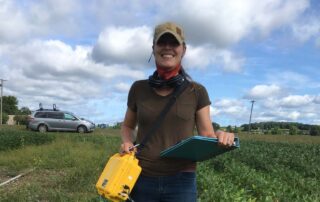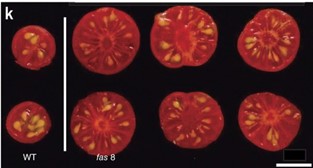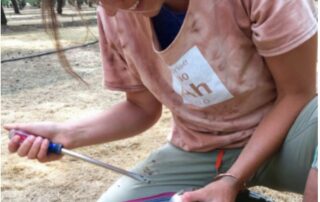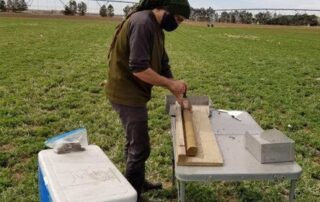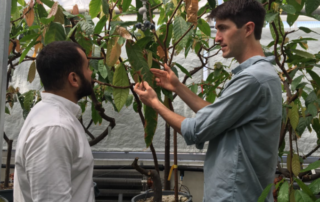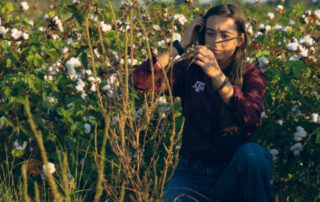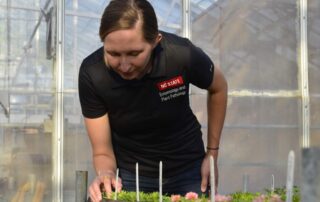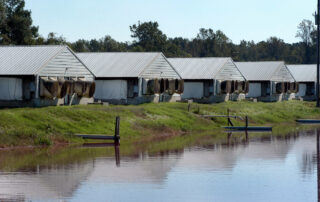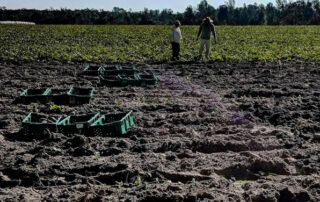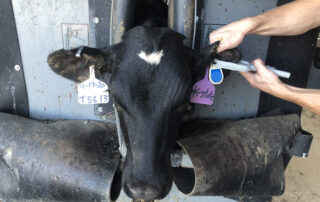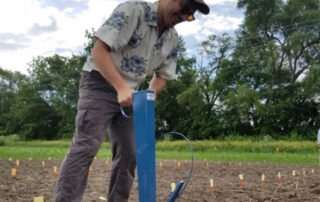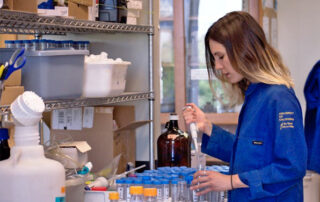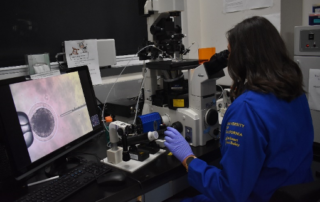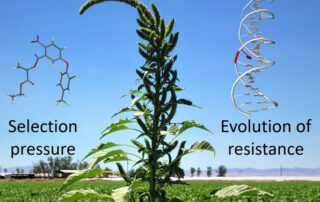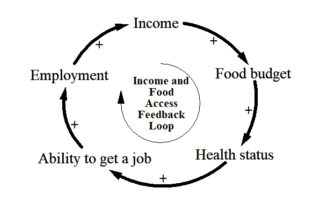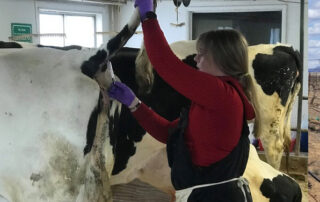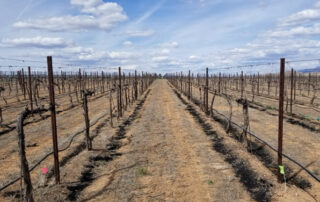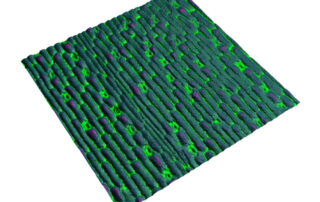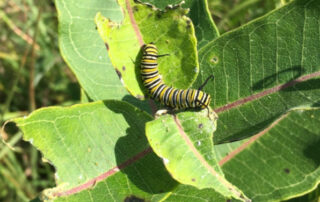From the FFAR Blog
Can Adding Carbon to the Soil Help us Manage Weeds?
By Maria Gannett, 2019-2022 FFAR Fellow
Soil is alive with microorganisms and keeping the soil microbial community healthy is key to plant growth. But how exactly are soil microbes and plant growth related? And how might we use this knowledge to develop a useful weed management tool for growers? These are the fundamental questions my research is seeking to answer.
Gene Editing is a Real Solution for Climate Change
By Nicholas Karavolias, FFAR Fellow 2020-2023
As a plant biologist, I have continually been inspired by the work of peer researchers developing innovative solutions to the severe impacts of climate change in natural and agricultural environments. I have been especially inspired by the disruption that the new editing tool CRISPR/Cas has brought in fields ranging from human medicine to agriculture.
Taking Science Beyond the Bench: Critical Reflections for Change-Oriented Research
By Krista Marshall, 2019-2022 FFAR Fellow
The urgency of climate change mitigation and adaptation in agriculture coincides with a call for all of us to envision food systems that promote equity, justice and dignity for all people who produce, process, distribute and consume food. As scientists, we can play an important and collaborative role in generating solutions to these challenges. We should reflect a collective vision that represents a diverse range of stakeholders in our scientific work.
Soil is Not Dirt
By Aaron Prairie, 2020-2023 FFAR Fellow
Dirt is dead. Soil, on the other hand, is teaming with bacteria, fungi, algae and other tiny creatures that are the foundation of a symbiotic ecosystem. Like all living things, soil has health; defined as the continued capacity of soil to function as a diverse living ecosystem that sustains plants, animals and humans. This definition speaks to the importance of managing soils, so they are sustainable for future generations. Decades of conventional agriculture practices have damaged soil health resulting in the loss of soil biodiversity across the globe.
Heavy Metal and Chocolate: Not the Best Pairing
By Zachary Dashner, 2018-2021 FFAR Fellow
I study Theobroma cacao, the plant that produces a seed that, when fermented, becomes cocoa, the raw ingredient for one of the most popular treats in the world: chocolate. Unfortunately for cacao and chocolate lovers around the world, a rogue element is “passing” as iron and entering the plants’ root system, damaging its health and accumulating in the seeds. The culprit is cadmium, a non-essential heavy metal and an environmental toxin.
Herbicide-Resistant Weeds: Looking Below the Soil Surface
By Sarah Kezar, 2020-2023 FFAR Fellow
Farmers have been fighting weeds for millennia. While the number and efficacy of tools to combat weed pressures have vastly improved, weed resistance is a continuing problem for crop productivity and profitability. Even when weeds appear to be destroyed, their seeds linger, hidden in the soil seedbank. A seedbank is the living memory of resistant weed species and the source for future weed infestations. They are the most impactful robber of yields worldwide and particularly destructive for cotton, which is the focus of my research.
Seeding a Resilient Wheat Microbiome
By Lindsey Becker, 2018-2021 FFAR Fellow
Plants, like all living things, have co-evolved along with microbes. Plants are complex ecosystems for microbes, where every part of the plant and every surface can host and be shaped by a distinct community of bacteria, fungi, viruses and other microorganisms.
While we have known for centuries that these microbes exist, only in the last few decades have researchers been able to understand the microbial communities associated with plants by identifying key species and estimating their abundance. We now know that there are microbial communities, “microbiomes,” that are intimately linked to different species of plants.
Systems Thinking for Sustainable Manure Management
By Alison Deviney, 2018-2021 FFAR Fellow
Sustainability is a popular buzzword these days, but what does it really mean to be sustainable? That often depends on who you ask, particularly when it comes to the food animal industry. A livestock producer might think of maintaining economic viability in their farming operation, while their downwind neighbor may feel it is more about having fresh air to breathe and clean water to drink. Meanwhile, animal protein consumers generally focus on price, although their perceptions of quality or animal welfare could also impact purchasing choices. We can think of sustainability as a three-legged table where one leg represents the economy, one leg represents the environment and one leg represents society. If any of these legs fails – or alternatively, outsizes the others – the table falls over, unable to sustain its balance.
Climate Change Requires Novel Sweetpotato Breeding Approaches
By Camilo Parada Rojas, 2018-2021 FFAR Fellow
Fields of rotten sweetpotatoes are not an uncommon occurrence in growing regions that experience hurricanes. A week before harvest, heavy rain can sweep through the area, flooding fields and promoting infection by opportunistic soil pathogens. Higher humidity and temperatures can increase plant susceptibility to these pathogens. While hurricanes may be temporary, the looming threat of more intensified and frequent severe weather events is looming. These severe weather events can have a long-term impact on pathogen populations, plant susceptibility, farm productivity and profitability.
Fine-tuning photosynthesis
By Dhruv Patel, 2019-2022 FFAR Fellow
The dimmer switch is one of the most underrated inventions. Whether you are in the mood for a cozy setting or facing an action-packed day of Zoom meetings, with the dimmer switch you can adjust the light setting freely. Having a finer level of control can add something extra to your life. My research hopes to do the same, but by fine-tuning the genes in the foods we eat.
Do Cows Count Their Steps?
By Miriam Martin, 2019-2022 FFAR Fellow
Have you ever wondered what your dog or cat does when you’re not around? Our team at Kansas State University has the same question, but we wonder about cows. Unlike nanny-cams, which might work well to see if your new puppy is doing okay, cattle have evolved to stoically conceal when they aren’t feeling well in order to avoid predation. Precision animal monitoring technologies (think of a super-charged Fitbit) allow us to collect data on how animals are spending every second of their day. This unlocks a wealth of information about their behavior such as rumination and activity – yes, how many steps they are getting in – and can help us better monitor their health and well-being.
Trait Selection, the Human Microbiome and Health
By Nate Korth, 2019-2022 FFAR Fellow
The plant breeders and geneticists I know all make the same joke, “We breed for three traits: yield, yield and yield”. The seeming hyperbole of this statement fades when you consider the traits improved in crops over the last thousand years. While we focus on disease or drought resistance, the trait we’re really talking about is yield. The work conducted to improve crop yield is truly amazing and must be continued; however, in the pursuit of yield, many traits related to food nutrition have been overlooked.
Biochar, A Negative Emissions Technology
By Danielle Gelardi, 2019-2022 FFAR Fellow
Scientific and entrepreneurial interest in biochar has grown dramatically in the last 10 years. Between 2009 and 2019, the number of research publications mentioning biochar grew from 47 to 3,209, and US patent applications increased from one to 120. It is no surprise that this incredible rise occurred simultaneously with an evolving consciousness around climate change, and the urgency with which the United States must act to address it. In 2018, the International Panel on Climate Change officially listed biochar as a negative emissions technology, signaling that it may hold the key to some of our most pressing environmental challenges.
Surrogate sire research: Precision genetics to improve the sustainability of steak
By Maci Mueller, 2018-2021 FFAR Fellow
Beef cattle are raised all around the world. They are able to convert one of nature’s most abundant and raw resources – grass – into one of the most nutrient dense food sources available. However, some breeds of cattle can convert feed into beef more efficiently than others.
Dairy Cattle Metabolic Capacity: Milking It for all It’s Worth
By Linda Beckett, 2019-2022 FFAR Fellow
Remember back in elementary school when you learned that cows have four stomachs? Did anyone else think that was bizarre, yet cool at the same time? Given that humans are “one stomach” or monogastric mammals, most of my third-grade peers deemed all ruminant species to be “weird”. In fact, ruminant digestive systems are incredibly efficient and much less strange than one may think. My research aims to better understand how the ruminant digestive system, specifically the liver, contributes to energy production and amino acid metabolism. These processes are necessary for a healthy cow and successful farmer.
Climate change and Dairy Farming: Beating the Heat
By Ananda Fontoura, 2018-2021 FFAR Fellow
Imagine cattle living in Brazil, where temperatures range from 95 to 104 degrees Fahrenheit year-round, suffering from grave heat exposure. Fast shallow breathing, profusely sweating, drooling and panting as they overheat, walking less, looking for shade and drinking triple the amount of water. As a practicing veterinarian in Pará State, this was an unforgettable sight I couldn’t unsee.
Combating Herbicide Resistance
By Abby Barker, 2018-2021 FFAR Fellow
If you have ever cared for a garden or a lawn, you know weeds are pesky plants that show up every year without fail. While they come in many shapes and sizes, weeds generally share some characteristics: fast growth, competitive, high seed production, genetic diversity and that one thing that universally defines them— their presence where we don’t want them.
Even the longest journey starts with one little step
By Francesco Cappai, 2018-2021 FFAR Fellow
Hello reader, let me introduce myself. I am Francesco Cappai, an Italian student currently pursuing a Ph. D. in the US at the University of Florida and a FFAR Fellow. I would like to share my story with special attention to our younger colleagues interested in pursuing a career in agricultural sciences who might find themselves wondering “Can my job make a difference?”.
Feedback Loops and Food Access
By Gwendolyn Donley, 2018-2021 FFAR Fellow
We see cycles of problems and solutions in our everyday lives. For example, when I’m happy, I play with my dog, Koschei, more, and when I play with Koschei more, I become happier. This is an example of a reinforcing feedback loop – events or behaviors linked in a way to amplify or balance each other over time. Some cycles, such as those aptly named “balancing feedback loops,” balance out over time ]. When I’m hungry, I eat. After I eat, I’m not hungry, so I stop eating for a while. And so the cycle continues. We live in a world of balancing and reinforcing loops pulling us toward an equilibrium. Right now, we’re experiencing disruptions to our normal equilibrium with system-wide shifts brought on by COVID-19.
Vitamin A, Healthy Cows, and Less Antibiotics
By Jaime Strickland, 2018-2021 FFAR Fellow
Hippocrates once said, “Let food be thy medicine and medicine be thy food”. That link between health and diet applies not only to people, but also to animals. As a FFAR Fellow, I am researching the role between the diet and health of dairy cows, specifically the role of vitamin A.
Can biochar help adapt agriculture to a hotter, dryer climate?
By Shelby Hoglund, 2018-2021 FFAR Fellow
Let’s talk about desert agriculture. Warning: you may feel thirsty. Agriculture in the arid Southwestern United States is productive year-round, with conditions that permit crops to grow the entire year. But with a predicted hotter, dryer climate looming in the near future, desert agriculture faces challenges.
Food for the Future: How Artificial Intelligence Can Improve Drought Resistance
By Kevin Xie, 2018-2021 FFAR Fellow
We breathe in oxygen and breathe out carbon dioxide (CO2); plants do the opposite. But how, exactly, do plants “breathe”? My interest in plants traces way back to when I was in grade school. I was given some ugly seeds to sow in pots on the balcony of my home and was amazed when spectacular flowers grew over the following months. Since then, I have enjoyed growing plants as a hobby and later further redirected my research interest into crops to help breeding for the future warmer and drier environment. Understanding how plants “breathe” is a key step in knowing how efficient they can produce.
Milkweeds: Medicine for Monarchs?
By Annie Krueger, 2018-2021 FFAR Fellow
Imagine a world where farmers could no longer use most insecticides, had limited access to herbicides and that these setbacks were caused by a butterfly.
The monarch butterfly, the same butterfly you may have once watched emerge from a chrysalis in a third-grade classroom, is currently being considered for listing under the Endangered Species Act. Milkweed, the host plant for monarchs breeding habitat, has been greatly reduced due to an expansion of farmland and increased use of herbicides, contributing to a dramatic population decline for monarchs.

